|
TennisOne Lessons
Improving Technique Among Senior Players by David Smith Notoriously, senior tennis players are the most difficult to convince that they could improve their game by making changes in their technique. Unfortunately, many senior players believe ‘you can't teach an old dog new tricks!' While this is a common belief, it is far from true!
The truth of the matter is that anyone, young or old, will meet with difficulty and frustration when making technical changes in their strokes. Regardless of whether the change is subtle or significant they will have even more difficulty implementing those changes in competition. This is because all players feel more confident with strokes and techniques they are most comfortable with. If a player's comfortable stroke is inadequate or limiting, the player is destine to perpetual mediocrity if in fact they always return to the comfortable swing patterns in competition. Senior players, more than others, tend to believe they are incapable of moving through any period of frustration or difficulty and it is this mentality that prohibits them from making the necessary changes. Legitimate Change All players—seniors included—must evaluate themselves (or be evaluated by a reputable pro) to determine specifically what shots or strokes are limiting their improvement. Is it the volley? The Serve? Groundstrokes? Once it is determined what strokes are limiting to player-improvement, then deciding what techniques should be implemented and then practiced is the next step. This article will deal with changes in the three main strokes: groundstrokes, serves and volleys. While suggesting changes in one stroke—let alone three—is challenging (and certainly a concept that merits greater detail than one article can provide), there are what I call quintessential tips and improvement strategies that are valuable to all senior players. Groundstrokes One of the problems seniors have with their ground game is the tendency to push or dink the ball over the net. This is one of the most prohibitive stroke patterns in terms of helping senior players move up to more competitive play.
Many senior players use one-handed strokes on their forehand and backhand. While the use of one hand provides a little better reach on groundstrokes, many senior players use questionable form in hitting these shots. As a result of such inferior form, the player has to resort to hitting the ball softer. (Dinking!) In addition, using poor form limits the effectiveness of a player's groundstrokes. Instead of hitting greater angles, more spin, or more pace, the player who uses inferior form will play a ‘one-dimensional' game of simply hitting the ball straight and relatively softly. One of the most effective techniques in improving forehand and backhand groundstrokes is practicing hitting two-handed on both shots. The use of two hands creates a stable, repetitive swing pattern, and for most, it allows greater and more natural topspin to be produced. In addition, the use of two hands helps diminish the stress to the joints by sharing the impact force between two hands instead of one. Those senior players who experience pain when hitting groundstrokes can get a new ‘lease on life' in terms of playing with little or no discomfort when hitting with two hands. There are plenty of instructional articles found in the TennisOne Lesson Library you can use to learn the two-handed strokes. While the two-handed forehand is far less known and understood by most pros, my 17 years teaching the stroke to both nationally ranked juniors as well as 60 and 70 year old seniors has shown me what an untapped learning tool and weapon this shot can become. One thing that will speed up the process of making this change is repetition. For example, if you are changing to a two-handed backhand, you can practice this stroke in front of a mirror or a sliding glass door where you can see your reflection. The use of imagery helps players develop new strokes faster. While videotape is an excellent evaluation tool, the immediate feedback of seeing your reflection while swinging any new stroke will help develop the desired stroke pattern faster.
Serves I have always said that the true legitimate factor in determining a players' NTRP rating is not the quality of their first serve, but the quality of their second serve. In senior tennis, this is equally true when trying to improve the quality of your competitive level. One of the major problems in senior tennis is the fact that most seniors play against the same senior opponents on a very regular basis. This familiarity breeds a contemptuous pattern of stagnant, non-improving tennis to all involved. Players learn to expect and perform within certain levels of play—and simply hope that they are having a little better day than their opponents! While this simplification has many exceptions to the rule, it is more true than not. Senior players who are guilty of this tend never to explore better ways to do things…especially on the serve! How does one improve their second serve? The answer to this is spin. While many senior players push, paddy cake, dink or just plain steer the ball in on their second serve, they will always be at the mercy of just two things: Gravity and trajectory. When a player hits the ball harder (defying gravity), the trajectory must be more precise to hit a successful serve. Without spin, the player must hit the ball only within a speed that they can control with relative consistency. However, with the proper spin, a player can not only hit the ball with more speed, more consistently, he or she can have a serve that is oftentimes more difficult to return than some first serves! In doubles this is so critical since the net man of the serving team can become a sitting duck if the serve is hit to weak!
Again, there are excellent articles on serving that address this aspect of spin. One tip I do recommend is to practice bouncing the ball with the correct continental grip and brushing down the outside of the ball. (Right side of the ball if you are right-handed.) This will help the player ‘feel' the strings brushing the ball. This simple drill can get you started in developing the slice serve, the foundation for all spin serves. The most important aspect to learning to serve well must include the grip. While the vast majority of 3.0 players serve with the novice Eastern forehand grip, you seldom, if ever, find 4.5 or 5.0 players using the same. The continental grip is the most dominant grip used among skilled players as it allows for proper and effective mechanics that apply the proper and effective spin necessary to hit big serves. Senior players can advance their serve through practicing the bouncing drill mentioned above and through lessons and clinics. Volleys In my opinion, the second serve and the volley are the two criteria most defining a player's competitive level. Many senior players can rally from the baseline all day long. But, their fear or lack of skill at the net prevents them from wanting to attack their opponents by coming in. When weak net players reluctantly have to come to the net, their inability to convert volleys into offensive shots or winners becomes obvious.
Like the serve, the grip is the most important aspect to acquiring a skilled and effective volley. Typically, players who use the novice eastern grips on their volley can't hit effective angles, can't get back low balls, have difficulty making the necessary grip changes in quick exchanges, and have a bad habit of hitting the volley much to flat. (Consequently, hitting even easy high balls that are close to the net into the net!) Senior players who are having said difficulty on their volley must evaluate their grip and subsequent stroke pattern. (The use of inferior grips also forces most players to use stroke patterns that are different than those used with the proper continental grip.) Senior players who decide to make the move to better volleys can go to the many excellent volley articles found in the TennisONE Lesson Library. The volley, hit correctly, requires little strength. I demonstrate the volley using two fingers to many senior players to show that with proper technique and timing, the volley requires minimal power and strength…areas that most senior players lack. Understanding too, that most volley winners are hit with placement, not power. Angle volleys, volleys hit at an opponent's feet, and volleys hit to the open court seldom need to be hit with the kind of power we associate with groundstrokes, serves, and overheads.
Conclusion I had a 50ish lady come to one of my clinics about a year ago, a good athlete, and overall good hand-eye coordination. Yet, she was no better than a 3.0 level player. When I asked her how long she had been playing, she said, “30 years or so.” While she had all the tools to be a far better player, (and played nearly 4 days a week!) her technique was so limiting, it was no wonder she was perpetually stuck at the 3.0 level. When asked if she would like to reach much higher levels of play, her response was a resounding yes. However, she doubted very much that she could move up since she seemed destined to play at the 3.0 level. When told that she could improve greatly with some changes in her technique, she balked and said, “Oh, I don't want to get worse.” Well, if she had been playing regularly for 30 years at the same 3.0 NTRP level, what did she really have to lose? Yes, for a period of time, any player making changes in their game will experience a lack of confidence and some frustrations. Yet, as with anything we practice, we will acquire affinity for that which we find initially difficult…whether you are 17 or 71. Each time we revert back to inferior form, we prohibit what we are trying to accomplish in favor of accomplishing only that which we are trying to eliminate! Your comments are welcome. Let us know what you think about Dave Smith's article by emailing us here at TennisOne .
|

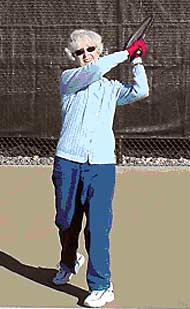
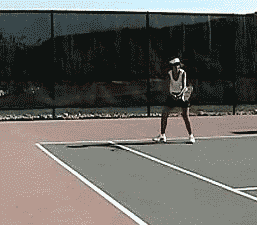
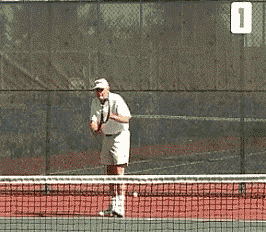
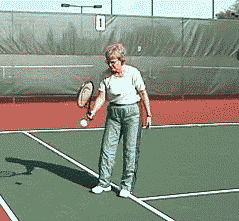
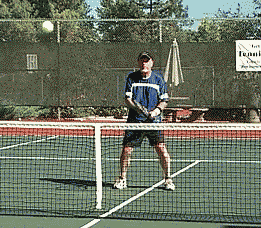 Using the eastern forehand grip, players tend to use the “wiper” move to hit balls that come to their backhand side.
Using the eastern forehand grip, players tend to use the “wiper” move to hit balls that come to their backhand side. 
 Your comments are welcome. Let us know what you think about this article by
Your comments are welcome. Let us know what you think about this article by